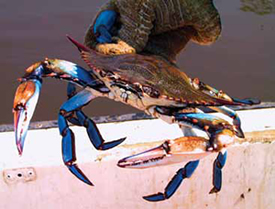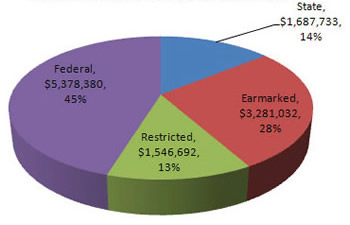Marine Resources
 The Marine Resources Division (MRD) is the chief advocate for, and steward of, the state’s living marine resources and their habitats. The Division is responsible for the management and conservation of the state’s marine resources. The division conducts routine monitoring and research on the state’s marine resources and makes recommendations for the management of those resources. The division is headquartered at the Marine Resources Center on Charleston Harbor with field offices in Bluffton and Bennett’s Point.
The Marine Resources Division (MRD) is the chief advocate for, and steward of, the state’s living marine resources and their habitats. The Division is responsible for the management and conservation of the state’s marine resources. The division conducts routine monitoring and research on the state’s marine resources and makes recommendations for the management of those resources. The division is headquartered at the Marine Resources Center on Charleston Harbor with field offices in Bluffton and Bennett’s Point.
The division monitors the status of marine species and the marine environment. Through the use of ocean-going vessels, modern laboratory equipment and computer generated maps, staff monitor relative abundance and trends of inshore and offshore finfish and shellfish populations and their environments. Biologists open and close marine fishing seasons, recommend size and catch limits for fish, track trends in abundance of marine species and review coastal development activities. Through the use of permits and permit conditions, the managers control the harvest of fish, shrimp, crab and shellfish.
Research is aimed largely at understanding life histories and the impacts of nature and man on important marine resources. A major goal of the Division is to proactively manage the state’s marine resources and habitats for sustainable use while enhancing the status and quality of those resources.
A field laboratory, the Waddell Mariculture Center, near Bluffton, is dedicated to the development of methods for the reproduction and grow-out of marine animals in animal ponds and tanks for private culture operations as well as production of hatchery-reared fish that can be released into coastal waters to bolster natural stocks if needed.
The saltwater recreational fishing license is a significant source of dedicated financial support for MRD programs. Two notable programs that use SC saltwater fishing license revenues are the Oyster Shell Recycling Program and the Marine Artificial Reef Program.
Oyster shell recycling saves taxpayer dollars by recovering discarded shells from oyster roasts that are then returned to the marine environment by the SCDNR. Shells attract larval oysters that grow into new oyster reefs and serve as finfish habitat as well as ecosystem engineers, filtering water and removing nitrogen. In addition to planting and recycling shell, the program monitors oyster recruitment to planted reefs to assure effectiveness and accountability and has involved the public - in the award-winning SCORE program - to help build a number of these reefs. These reefs also serve as critical habitat for a number of game fish.
The Marine Artificial Reef program was established in 1975 and the 49 permitted artificial reef sites currently have a total economic impact exceeding $83 million while supporting approximately 1,000 jobs. A survey of SC saltwater recreational license holders in 2006 found that 32% of active saltwater anglers fish on the state’s permitted reef sites. Recycling of waste materials into offshore habitat is an example of improved economic benefit from environmental conservation. Over the past 15 years, 277 deployments have expanded the amount of fishable bottom on these sites by 21.5 million cubic feet.
The SC seafood industry is an important component of the state’s coastal economy and heritage. It plays an important role in the lives of 1,500-2,000 commercial fishermen and wholesale and retail seafood dealers, another significant component of the MRD customer base. It also provides a foundation for the state’s growing coastal tourism industry. During calendar year 2009, the total weight of wild saltwater stocks landed in this state was 9.6 million pounds with an ex-vessel value of $17.2 million.
| Marine Resources | Source of Funds | ||
|---|---|---|---|
 |
Federal | $5,378,380 | 45% |
| State | $1,687,733 | 14% | |
| Earmarked | $3,281,032 | 28% | |
| Restricted | $1,546,692 | 13% | |
Marine Resources (MR): MR FY 2009-10 – Highlights
- Stocked fish into multiple SC estuaries through the finfish research program: 1,101,297 fingerling; 32,136,182 larval; 2,000 sub-adult red drum; and 1,392 medium and 54 large cobia.
- Conducted Marine Resource-based educational programs for approximately 21,000 youth/students and 13,480 adults, free of charge.
- Completed the Cooperative Fisheries Research program that included 46 separate research projects that involved a total of 500 recreational and commercial fishermen.
- Completed 14 artificial reef construction projects on 11 sites, including the addition of 5 barges, 2 steelhulled trawlers, 66 armored personnel carriers, and 1 concrete culvert pipe.
- Partnered with private business and government to protect water quality by providing access to pump-out facilities.
- Progressed significantly in a large-scale shellfish restoration program in Charleston Harbor in cooperation with the State Ports Authority.
- Successfully completed the renovation of the main laboratory building with numerous energy saving modifications – all well within budget.
- Installed a solar water heating system for the main lab building.
- Installed a Rainwater Recovery Cistern and Irrigation System demonstration project.
- Completed the first quantitative evaluation of fishing effort and catch rates in the night-time flounder gigging fishery.
